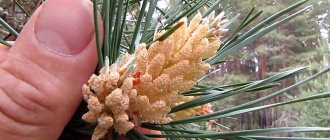Bushes and trees
0
402
Article rating
Kira Stoletova
The evergreen mountain pine Pumilio with creeping shoots creates a dense and lush squat crown in the shape of a ball. The compact bush grows well in a sunny place, easily tolerates drought, severe frosts and is not picky about soil fertility. Therefore, it is readily used in landscape design in the central and middle regions.
Mountain pine Pumilio - description, rules of planting and care
Characteristics of the variety
Description of the external parameters of the mountain pine Pumilio (full name pinus mugo var. pumilio):
- maximum height of an adult plant is 3 m, width – 2.5-3 m;
- in young bushes the shape of the crown is flat-round, cushion-shaped, in old bushes it becomes widely spread;
- grows slowly - annual growth is 5 cm in length, 12 cm in width;
- needles are green, prickly, length – 2-3 cm;
- shoots are light brown, erect;
- the first fruiting occurs in the 7th year of cultivation;
- the fruits are cone-shaped cones, chocolate-colored, their sizes vary from 3.5 to 4.5 cm.
The culture has good winter hardiness and is widespread in Central and Eastern Europe, the Balkans and the Carpathians.
The price for a seedling with a height of 40 to 70 cm is 1200 rubles.
origin of name
The genus name Pinus refers to the Sanskrit word "pitu" or the Latin "pix, pìcis", meaning resinous, and the Celtic term for mountain, rock, which is associated with the habitat of many plant species. The name Mugo is an Italian term meaning "small mountain pine", or a diminutive of the Arabic "musk" (musk) due to the resinous scent of the plant's pine cones and wood. The meaning of the word Pumilio (Latin) is dwarf. The use of the abbreviation var in the name of the plant. (from Latin varietas) means variety.
Landing rules
It is not difficult to grow these needles on the site; the main thing is to choose high-quality material, plant it correctly and provide the necessary care.
Selection of seedlings
You can buy this plant in a specialized nursery or in a gardening store, the main thing is that it meets all the withered characteristics of the variety.
When choosing, carefully inspect the above-ground part - one should be alive, the shoots and trunk with even and smooth bark, the needles a uniform rich green color.
The optimal height of a seedling for planting is 50-70 cm. It is better to take bushes 2-3 years old with closed roots, which will not dry out during transplantation to the site.
Place and soil
Pumilio pine likes to grow in a sunny location with deep groundwater and protection from drafts.
Light, loose soil is suitable - sandy, clayey, siliceous with a neutral level of acidity and a low degree of salinity. In shady areas on salty soil, the plant begins to weaken its immunity against disease and grows slowly.
This variety tolerates gas and dust well, so it can fully develop both in the garden and outside, along roads.
To deoxidize the soil, 300 g of limestone, chalk, dolomite or calcite must be added to a 1 m² bed. Sand and peat - 2 buckets each - will help make it loose and light. To increase nutritional value, additionally sprinkle the bed with 100 g of superphosphate, 80 g of potassium nitrate and 70 g of azophosphate. Then deep digging and leveling are carried out.
Landing technique
This compact plant should be planted according to the scheme - 1x1 m.
First, they dig holes 60 cm deep and 80 cm wide. Then drainage from pebbles, crushed stone or broken brick is laid at the bottom, then filled to half with a nutrient composition of sand, peat and turf soil (1: 1: 1). They lower the earthen ball, fill all the voids with fertile soil, compact it and spill it generously - a bucket per seedling.
When planting, it is important that the root collar of the bush is slightly above the surface of the soil, otherwise it will quickly rot and die.
To prevent rapid evaporation of moisture, the tree trunk area is mulched with peat soil or pine sawdust.
Basic care
Caring for coniferous shrubs is not difficult; all it requires is regular moistening, periodic fertilization, pruning and loosening.
Watering
Water the pine tree as needed
The first moistening is carried out a week after planting, then every 2 days for 10 days. Moisture promotes rapid rooting and growth of green mass. The frequency of subsequent watering depends on weather conditions and precipitation.
Loosening and mulching
The loosening procedure is necessary to maintain the moisture and breathability of the soil. Loosen the soil superficially and every other day after each watering. Additionally, row-spacings are weeded and unnecessary vegetation is removed.
Mulching with peat and sawdust from conifers helps maintain the soil acidity necessary for conifers, protects the roots from drying out and prevents the growth of weeds.
Feeding
The main care for this crop consists of regular application of fertilizers. In the first year of planting, the plants do not require nutrition, since the nutrients stored on the site will last until spring.
At the end of April or early May, they can be fed with nitrogen-containing preparations - nitrophoska, ammophoska or urea. Prepare a solution of 30 g per 10 liters of water. Consumption per seedling – 5 liters.
The second time, young shrubs are fed with a complex mineral composition of superphosphate (15 g) and potassium nitrate (10 g) in a bucket of water. The amount of nutrient liquid per plant is 5 liters.
Trimming
This miniature shrub does not require a shaping pruning, as it initially forms a thick, beautiful spherical crown.
Sanitary pruning, which is carried out in early spring, will not be superfluous - all branches damaged by frost, winds, diseases and parasites are removed. For this operation, a sterile pruning shears is used, and the cut sites are irrigated with a solution of copper sulfate to avoid infection.
Shelter for the winter
Adult plants easily tolerate wintering without additional shelter - the only thing they require is hilling the tree trunk area with peat.
Young seedlings have weak immunity, so they are first mulched, then the branches are tightly tied to the central conductor with a rope or twine. Cover the aboveground part with spruce branches or burlap. The shelter is removed in the spring - in April, when the sun is not so active.
How to grow Pumilio in a garden plot?
The most important thing when planting a plant is to choose a well-lit area. Don't pay attention to the soil. The shrub can even grow in dunes . Environmental conditions, even the worst, do not have a detrimental effect on the shrub. A small amount of nutrients in the soil, air polluted by cars and factories will not interfere with the growth of Pumilio.
When planting a plant, dig a hole of the required volume. If the soil is very acidic, add slaked lime to the hole.
Reproduction methods
There are three ways to propagate this crop - seeds, cuttings and grafting. The most effective and fastest way is using cuttings.
To do this, use an adult plant over 5 years old, cut the apical shoots up to 20 cm long with a piece of last year’s bark (heel). The lower part is cleaned, dipped for an hour in a solution of a growth stimulator and immediately planted in a nutritious, moist substrate of turf soil, peat and sand (1: 1: 1).
You can keep cuttings in a greenhouse or at home, providing several important conditions:
- temperature within 20-23°C;
- humidity at 60%;
- daily ventilation;
- irrigation as the soil dries out;
- weed removal and loosening.
As soon as the first shoots appear on the shoots (after about 2-3 months), you can remove the shelter and move the plants to a cool place with a temperature of 18-19°C.
Transplantation into open ground is carried out no earlier than a year after germination in room conditions. During this period, conifers grown from cuttings will grow a good root system, become stronger and more easily survive the resulting stress.
Such propagation makes it possible to obtain many young specimens with all the varietal characteristics and characteristics of the mother bush.
Diseases and pests
Infections can affect the plant in autumn
The peak development of sores in the mountain pine Pumilio occurs in the autumn, when the weather outside is persistently damp and cold. These conditions are ideal for rust to appear.
Signs of damage: the formation of numerous yellow or red spots on the trunk and shoots.
The infection quickly spreads to other nearby trees and bushes. Therefore, you need to act urgently - remove damaged areas on weak bushes and treat the crown with a solution of copper sulfate or Ridomil Gold. Heavily infected specimens should be disposed of and burned.
For prevention, it is better to plant pine needles away from birch trees, avoid dense plantings, thin out the above-ground parts in a timely manner and remove organs injured by the fungus.
Of the parasites, this plant is plagued by the subbark bug, which sucks the juices from the stems and leads to their drying out and death. For control and prevention, insecticides are used - Actellik, Aktaru, Enzhio. Spraying is carried out in early spring and autumn.
To cope with aphids, spider mites, scale insects and sawflies, you will need to treat the crown and soil around the trunk three times with Aktara, Skor or Fundazol.
Regular removal of weeds, loosening the soil, adherence to the planting scheme and periodic inspection for signs of damage will help prevent the invasion of parasites.
Pine diseases
As you already know, everything is simple with this plant: use, planting, and care. Mountain pine is extremely popular because it pleases the eye for a long time and requires a minimum of care. In addition, Pumilio pine is resistant to various diseases, which cannot be said about other conifers.
The only problem is a fungal disease. Schutte disease is characterized by blackening of branches and rapid drying of needles. It is easy to cope with this scourge - you should treat the plant with a fungicide.
But if this disease appears in a plant in the first 3 years of its life, most likely the seedling will die. Therefore, seedlings should be purchased from trusted gardening associations.
Application in landscape
The small size of the plant does not require special care and takes root well in any type of soil - thanks to these qualities, it has become a popular choice in landscape design.
- Lush, evergreen shrubs are an excellent decoration for every composition in a rock garden, mixborder, rock garden, ridge or flower bed.
- Planting a dwarf conifer with columnar or spreading squat varieties of juniper with blue and gray needles will be effective. This contrast and combination of different shapes is an original design solution for a garden plot.
- Mountain pine Pumilio looks beautiful along alleys and borders; it is used for landscaping city parks.
- Some grow low-growing shrubs as a potted crop and place them next to the gazebo, near terraces or arches.
- The multi-level composition looks amazing, with pine trees planted at the top and mosses and heather on the lower steps.
Peculiarities
The outstanding qualities of mountain pine Pumilio are its unpretentiousness, frost resistance and drought resistance. But at an early age (up to 3 years), young plants need protection from the cold and scorching spring sun rays. Burlap is good for covering.
It is freely ventilated and allows sufficient light to pass through. Another advantage of Pumilio is its high tolerance to pruning, which makes this shrub very popular among landscape designers.
Mountain pine Pumilio is the salvation of plots and gardens with poor soils. The lack of nutrients for this plant is not critical. The developed root system, which includes many thin shoots, is able to adapt to nutritional deficiencies and the existing moisture regime. The plant can be planted in both dry and marshy areas (provided that root drainage is installed). The bush can grow in sand. Combined with high wind resistance, this property allows it to be planted on coastal dunes. It is also not afraid of snowfalls: its branches have good flexibility, thanks to which they never break under the weight of snow mass or soil sediments.
Other dwarf forms of mountain pine, for example, Pug, Minikin, Gnome, may have similar seedlings. A professional gardener will certainly be able to distinguish them at any age, but ordinary people can confuse them. As they develop, these shrubs acquire their own unique shape and size. Thus, in 10 years, Minikin will only grow to 40 cm in height, while the Pug is characterized by a spherical crown with an uneven texture.
Differences between Pumilio and other mountain pines
You can distinguish this variety of mountain pine from other subspecies; to do this, you should read their description.
- Brevifolia. The crown is barrel-shaped, about 50 cm high. The needles are green.
- Winter Gold. A dwarf, slowly growing shrub measuring 50x90 cm. The above-ground part is compact, spherical with golden needles in winter and light green in summer.
- Dwarf. The plant is the same in height and width - about 2 m. The shape of the crown is neat, spherical, the needles are greenish-gray.
- Kobold. A shrub 1 m long with a wide, spherical aerial part, green needles with a bluish tint.
- Pug. Height 1.4-1.5 m, surface spherical, rounded. This variety of mountain pine grows slowly - it produces about 10 cm of growth per year.
- Columnaris. Tall bush plant - reaches 2.5 m, circumference - 1 m.
- Ophir. Dwarf variety, crown shape flat, pin-shaped, height 35 cm, diameter – 55 cm. Golden needles.
- Frisia. A large plant measuring 2x1.5 m. The needles are emerald in color; closer to winter they take on a dark green hue.
- Hampi. Dwarf ball pine 1 m long, 1.4 m in diameter.
Reviews from gardeners
Many of those who have been growing this crop for several years leave positive reviews. They note that the shrub practically does not get sick, pleases with its greenery and beauty all year round, and can grow on any type of soil.
Everyone likes that the ephedra is compact in shape and goes well with all types of indoor vegetation, which is why it is so readily used in landscape design;
Thanks to its good growth and the ability to independently form a beautiful crown, Pumilio pine is used not only in private but also in industrial gardening - to decorate parks, alleys and other public areas.











